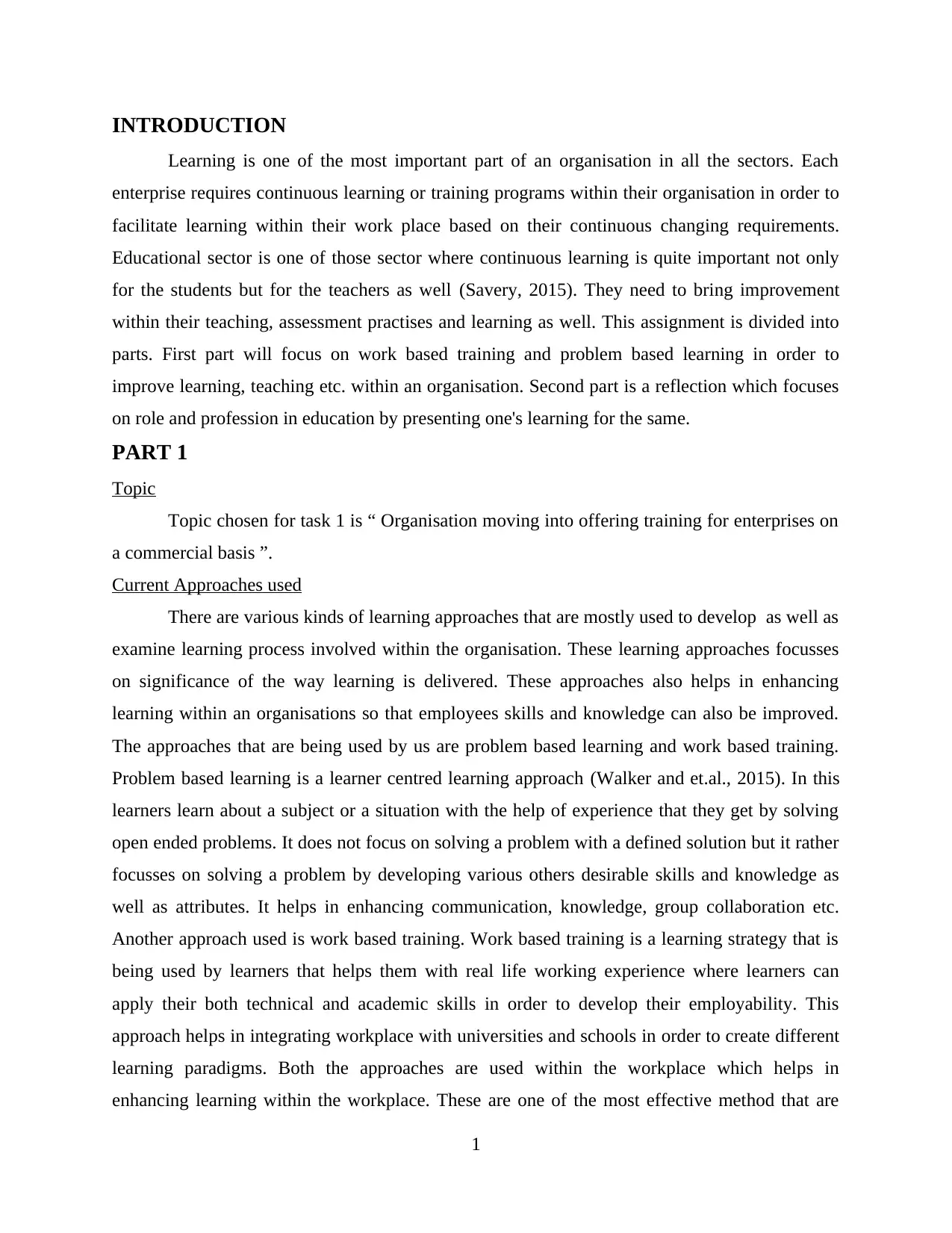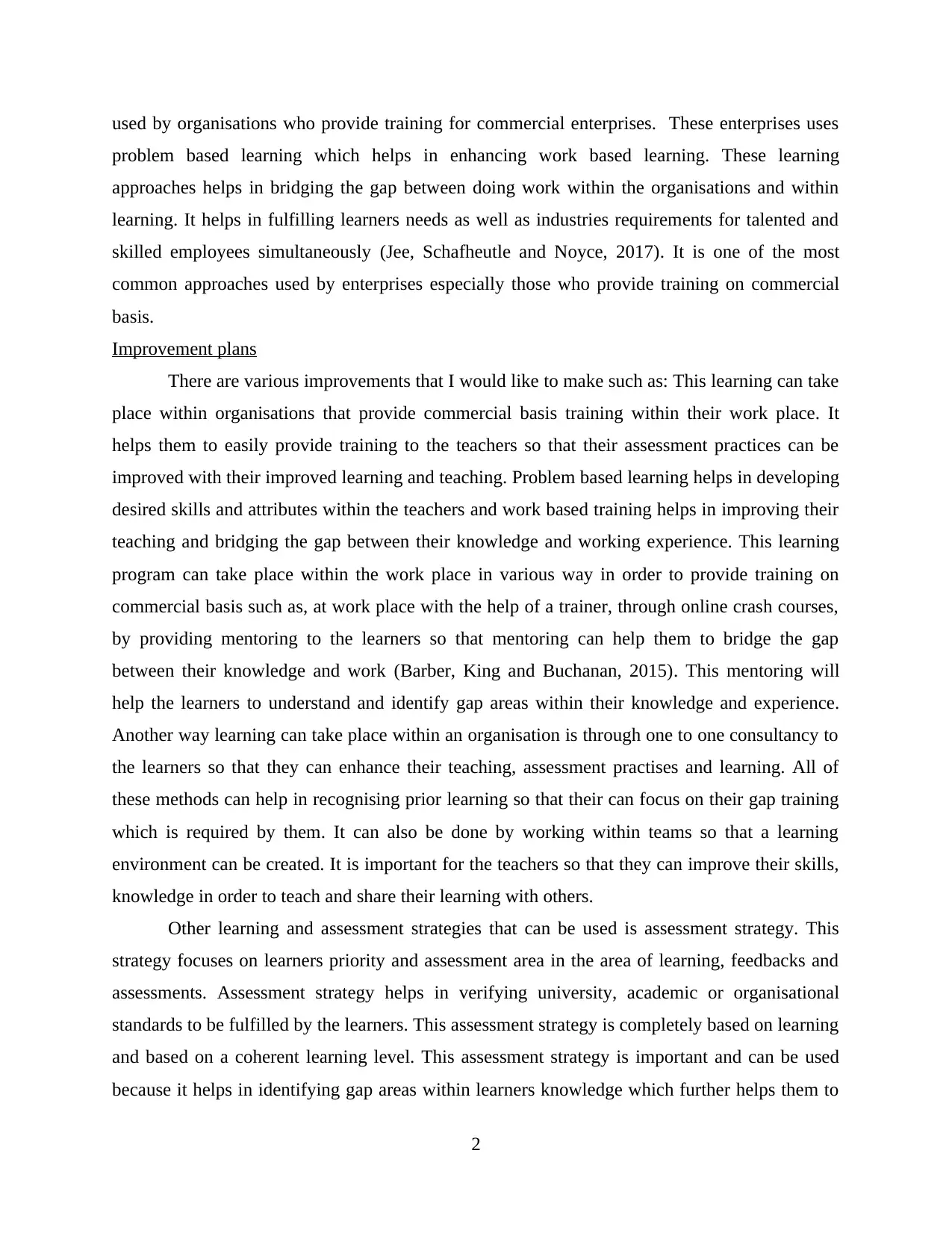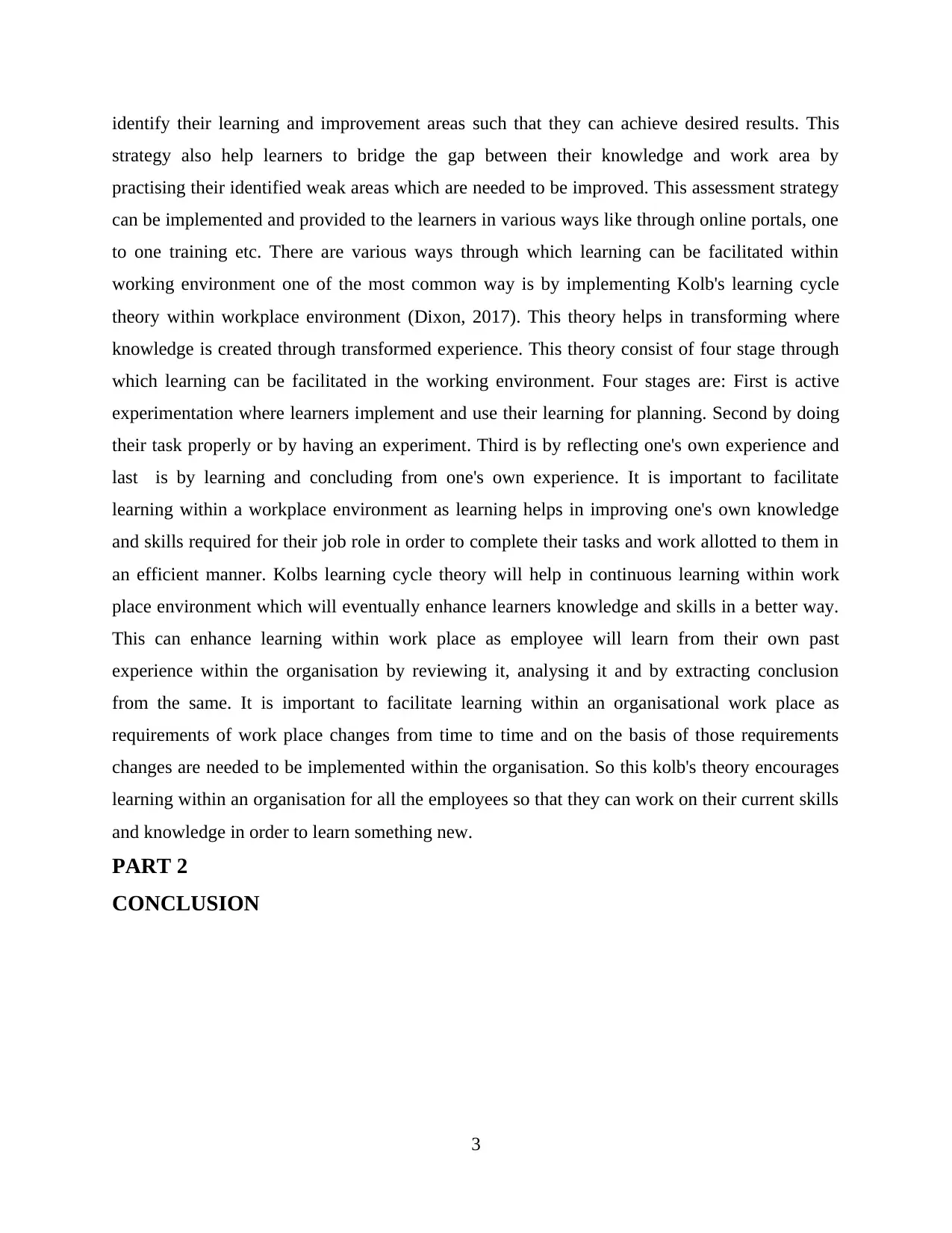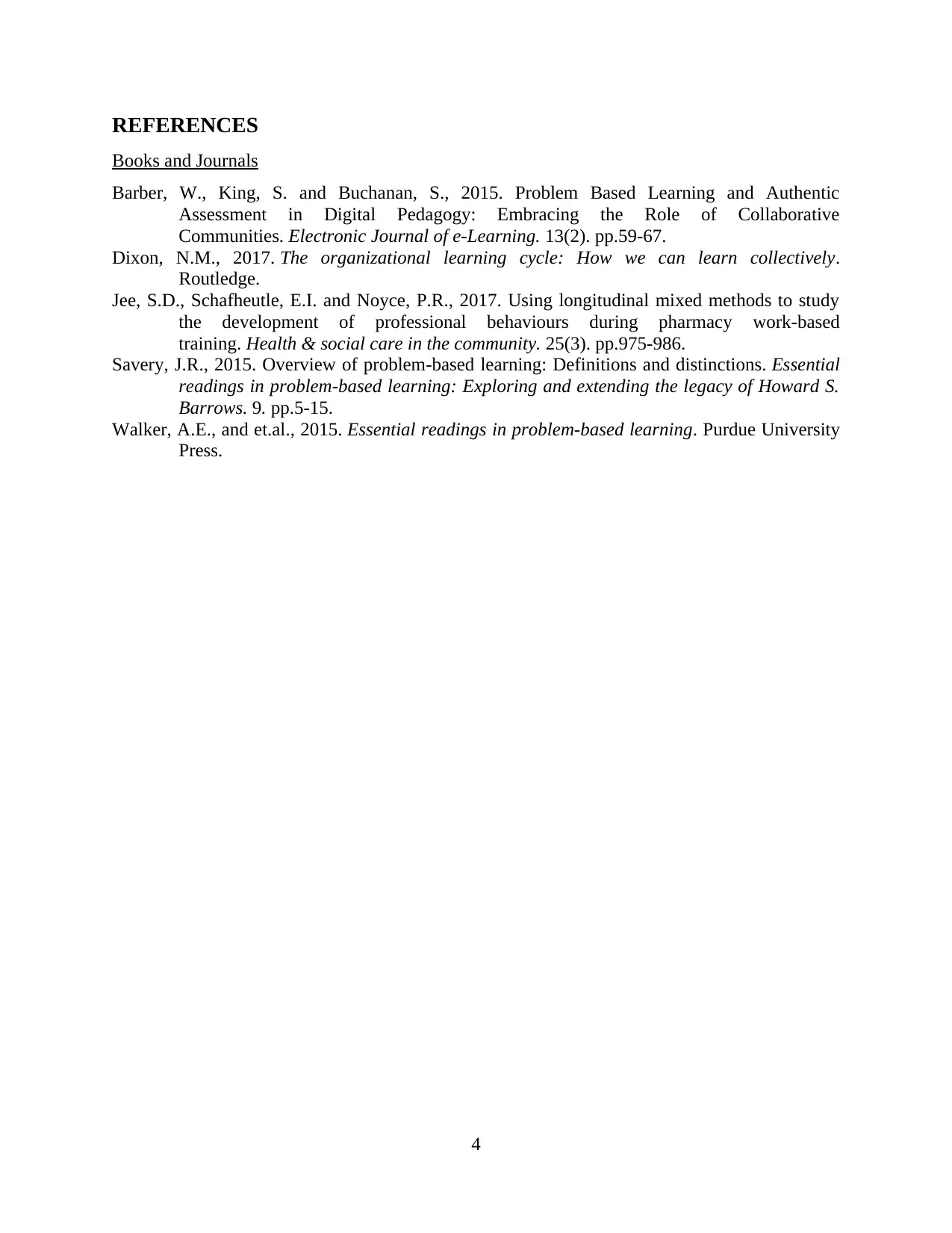Improve Learning: Work Based Training and Problem Based Learning
VerifiedAdded on 2021/02/19
|6
|1431
|23
Essay
AI Summary
This essay discusses the importance of continuous learning in organizations, particularly in the educational sector, focusing on work-based training and problem-based learning approaches. It highlights how these methods enhance learning and teaching by bridging the gap between knowledge and practical experience. The essay also includes improvement plans, such as implementing Kolb's learning cycle and assessment strategies, to facilitate continuous learning within the workplace. It emphasizes the role of these approaches in developing desired skills and attributes in teachers, improving assessment practices, and meeting the evolving requirements of the workplace. This student contributed the document; Desklib is a website providing study tools for students.

EDUCATION
Paraphrase This Document
Need a fresh take? Get an instant paraphrase of this document with our AI Paraphraser

Table of Contents
INTRODUCTION...........................................................................................................................1
PART 1............................................................................................................................................1
Topic............................................................................................................................................1
Current Approaches used.............................................................................................................1
Improvement plans.......................................................................................................................2
PART 2............................................................................................................................................3
CONCLUSION................................................................................................................................3
REFERENCES................................................................................................................................4
INTRODUCTION...........................................................................................................................1
PART 1............................................................................................................................................1
Topic............................................................................................................................................1
Current Approaches used.............................................................................................................1
Improvement plans.......................................................................................................................2
PART 2............................................................................................................................................3
CONCLUSION................................................................................................................................3
REFERENCES................................................................................................................................4

INTRODUCTION
Learning is one of the most important part of an organisation in all the sectors. Each
enterprise requires continuous learning or training programs within their organisation in order to
facilitate learning within their work place based on their continuous changing requirements.
Educational sector is one of those sector where continuous learning is quite important not only
for the students but for the teachers as well (Savery, 2015). They need to bring improvement
within their teaching, assessment practises and learning as well. This assignment is divided into
parts. First part will focus on work based training and problem based learning in order to
improve learning, teaching etc. within an organisation. Second part is a reflection which focuses
on role and profession in education by presenting one's learning for the same.
PART 1
Topic
Topic chosen for task 1 is “ Organisation moving into offering training for enterprises on
a commercial basis ”.
Current Approaches used
There are various kinds of learning approaches that are mostly used to develop as well as
examine learning process involved within the organisation. These learning approaches focusses
on significance of the way learning is delivered. These approaches also helps in enhancing
learning within an organisations so that employees skills and knowledge can also be improved.
The approaches that are being used by us are problem based learning and work based training.
Problem based learning is a learner centred learning approach (Walker and et.al., 2015). In this
learners learn about a subject or a situation with the help of experience that they get by solving
open ended problems. It does not focus on solving a problem with a defined solution but it rather
focusses on solving a problem by developing various others desirable skills and knowledge as
well as attributes. It helps in enhancing communication, knowledge, group collaboration etc.
Another approach used is work based training. Work based training is a learning strategy that is
being used by learners that helps them with real life working experience where learners can
apply their both technical and academic skills in order to develop their employability. This
approach helps in integrating workplace with universities and schools in order to create different
learning paradigms. Both the approaches are used within the workplace which helps in
enhancing learning within the workplace. These are one of the most effective method that are
1
Learning is one of the most important part of an organisation in all the sectors. Each
enterprise requires continuous learning or training programs within their organisation in order to
facilitate learning within their work place based on their continuous changing requirements.
Educational sector is one of those sector where continuous learning is quite important not only
for the students but for the teachers as well (Savery, 2015). They need to bring improvement
within their teaching, assessment practises and learning as well. This assignment is divided into
parts. First part will focus on work based training and problem based learning in order to
improve learning, teaching etc. within an organisation. Second part is a reflection which focuses
on role and profession in education by presenting one's learning for the same.
PART 1
Topic
Topic chosen for task 1 is “ Organisation moving into offering training for enterprises on
a commercial basis ”.
Current Approaches used
There are various kinds of learning approaches that are mostly used to develop as well as
examine learning process involved within the organisation. These learning approaches focusses
on significance of the way learning is delivered. These approaches also helps in enhancing
learning within an organisations so that employees skills and knowledge can also be improved.
The approaches that are being used by us are problem based learning and work based training.
Problem based learning is a learner centred learning approach (Walker and et.al., 2015). In this
learners learn about a subject or a situation with the help of experience that they get by solving
open ended problems. It does not focus on solving a problem with a defined solution but it rather
focusses on solving a problem by developing various others desirable skills and knowledge as
well as attributes. It helps in enhancing communication, knowledge, group collaboration etc.
Another approach used is work based training. Work based training is a learning strategy that is
being used by learners that helps them with real life working experience where learners can
apply their both technical and academic skills in order to develop their employability. This
approach helps in integrating workplace with universities and schools in order to create different
learning paradigms. Both the approaches are used within the workplace which helps in
enhancing learning within the workplace. These are one of the most effective method that are
1
⊘ This is a preview!⊘
Do you want full access?
Subscribe today to unlock all pages.

Trusted by 1+ million students worldwide

used by organisations who provide training for commercial enterprises. These enterprises uses
problem based learning which helps in enhancing work based learning. These learning
approaches helps in bridging the gap between doing work within the organisations and within
learning. It helps in fulfilling learners needs as well as industries requirements for talented and
skilled employees simultaneously (Jee, Schafheutle and Noyce, 2017). It is one of the most
common approaches used by enterprises especially those who provide training on commercial
basis.
Improvement plans
There are various improvements that I would like to make such as: This learning can take
place within organisations that provide commercial basis training within their work place. It
helps them to easily provide training to the teachers so that their assessment practices can be
improved with their improved learning and teaching. Problem based learning helps in developing
desired skills and attributes within the teachers and work based training helps in improving their
teaching and bridging the gap between their knowledge and working experience. This learning
program can take place within the work place in various way in order to provide training on
commercial basis such as, at work place with the help of a trainer, through online crash courses,
by providing mentoring to the learners so that mentoring can help them to bridge the gap
between their knowledge and work (Barber, King and Buchanan, 2015). This mentoring will
help the learners to understand and identify gap areas within their knowledge and experience.
Another way learning can take place within an organisation is through one to one consultancy to
the learners so that they can enhance their teaching, assessment practises and learning. All of
these methods can help in recognising prior learning so that their can focus on their gap training
which is required by them. It can also be done by working within teams so that a learning
environment can be created. It is important for the teachers so that they can improve their skills,
knowledge in order to teach and share their learning with others.
Other learning and assessment strategies that can be used is assessment strategy. This
strategy focuses on learners priority and assessment area in the area of learning, feedbacks and
assessments. Assessment strategy helps in verifying university, academic or organisational
standards to be fulfilled by the learners. This assessment strategy is completely based on learning
and based on a coherent learning level. This assessment strategy is important and can be used
because it helps in identifying gap areas within learners knowledge which further helps them to
2
problem based learning which helps in enhancing work based learning. These learning
approaches helps in bridging the gap between doing work within the organisations and within
learning. It helps in fulfilling learners needs as well as industries requirements for talented and
skilled employees simultaneously (Jee, Schafheutle and Noyce, 2017). It is one of the most
common approaches used by enterprises especially those who provide training on commercial
basis.
Improvement plans
There are various improvements that I would like to make such as: This learning can take
place within organisations that provide commercial basis training within their work place. It
helps them to easily provide training to the teachers so that their assessment practices can be
improved with their improved learning and teaching. Problem based learning helps in developing
desired skills and attributes within the teachers and work based training helps in improving their
teaching and bridging the gap between their knowledge and working experience. This learning
program can take place within the work place in various way in order to provide training on
commercial basis such as, at work place with the help of a trainer, through online crash courses,
by providing mentoring to the learners so that mentoring can help them to bridge the gap
between their knowledge and work (Barber, King and Buchanan, 2015). This mentoring will
help the learners to understand and identify gap areas within their knowledge and experience.
Another way learning can take place within an organisation is through one to one consultancy to
the learners so that they can enhance their teaching, assessment practises and learning. All of
these methods can help in recognising prior learning so that their can focus on their gap training
which is required by them. It can also be done by working within teams so that a learning
environment can be created. It is important for the teachers so that they can improve their skills,
knowledge in order to teach and share their learning with others.
Other learning and assessment strategies that can be used is assessment strategy. This
strategy focuses on learners priority and assessment area in the area of learning, feedbacks and
assessments. Assessment strategy helps in verifying university, academic or organisational
standards to be fulfilled by the learners. This assessment strategy is completely based on learning
and based on a coherent learning level. This assessment strategy is important and can be used
because it helps in identifying gap areas within learners knowledge which further helps them to
2
Paraphrase This Document
Need a fresh take? Get an instant paraphrase of this document with our AI Paraphraser

identify their learning and improvement areas such that they can achieve desired results. This
strategy also help learners to bridge the gap between their knowledge and work area by
practising their identified weak areas which are needed to be improved. This assessment strategy
can be implemented and provided to the learners in various ways like through online portals, one
to one training etc. There are various ways through which learning can be facilitated within
working environment one of the most common way is by implementing Kolb's learning cycle
theory within workplace environment (Dixon, 2017). This theory helps in transforming where
knowledge is created through transformed experience. This theory consist of four stage through
which learning can be facilitated in the working environment. Four stages are: First is active
experimentation where learners implement and use their learning for planning. Second by doing
their task properly or by having an experiment. Third is by reflecting one's own experience and
last is by learning and concluding from one's own experience. It is important to facilitate
learning within a workplace environment as learning helps in improving one's own knowledge
and skills required for their job role in order to complete their tasks and work allotted to them in
an efficient manner. Kolbs learning cycle theory will help in continuous learning within work
place environment which will eventually enhance learners knowledge and skills in a better way.
This can enhance learning within work place as employee will learn from their own past
experience within the organisation by reviewing it, analysing it and by extracting conclusion
from the same. It is important to facilitate learning within an organisational work place as
requirements of work place changes from time to time and on the basis of those requirements
changes are needed to be implemented within the organisation. So this kolb's theory encourages
learning within an organisation for all the employees so that they can work on their current skills
and knowledge in order to learn something new.
PART 2
CONCLUSION
3
strategy also help learners to bridge the gap between their knowledge and work area by
practising their identified weak areas which are needed to be improved. This assessment strategy
can be implemented and provided to the learners in various ways like through online portals, one
to one training etc. There are various ways through which learning can be facilitated within
working environment one of the most common way is by implementing Kolb's learning cycle
theory within workplace environment (Dixon, 2017). This theory helps in transforming where
knowledge is created through transformed experience. This theory consist of four stage through
which learning can be facilitated in the working environment. Four stages are: First is active
experimentation where learners implement and use their learning for planning. Second by doing
their task properly or by having an experiment. Third is by reflecting one's own experience and
last is by learning and concluding from one's own experience. It is important to facilitate
learning within a workplace environment as learning helps in improving one's own knowledge
and skills required for their job role in order to complete their tasks and work allotted to them in
an efficient manner. Kolbs learning cycle theory will help in continuous learning within work
place environment which will eventually enhance learners knowledge and skills in a better way.
This can enhance learning within work place as employee will learn from their own past
experience within the organisation by reviewing it, analysing it and by extracting conclusion
from the same. It is important to facilitate learning within an organisational work place as
requirements of work place changes from time to time and on the basis of those requirements
changes are needed to be implemented within the organisation. So this kolb's theory encourages
learning within an organisation for all the employees so that they can work on their current skills
and knowledge in order to learn something new.
PART 2
CONCLUSION
3

REFERENCES
Books and Journals
Barber, W., King, S. and Buchanan, S., 2015. Problem Based Learning and Authentic
Assessment in Digital Pedagogy: Embracing the Role of Collaborative
Communities. Electronic Journal of e-Learning. 13(2). pp.59-67.
Dixon, N.M., 2017. The organizational learning cycle: How we can learn collectively.
Routledge.
Jee, S.D., Schafheutle, E.I. and Noyce, P.R., 2017. Using longitudinal mixed methods to study
the development of professional behaviours during pharmacy work‐based
training. Health & social care in the community. 25(3). pp.975-986.
Savery, J.R., 2015. Overview of problem-based learning: Definitions and distinctions. Essential
readings in problem-based learning: Exploring and extending the legacy of Howard S.
Barrows. 9. pp.5-15.
Walker, A.E., and et.al., 2015. Essential readings in problem-based learning. Purdue University
Press.
4
Books and Journals
Barber, W., King, S. and Buchanan, S., 2015. Problem Based Learning and Authentic
Assessment in Digital Pedagogy: Embracing the Role of Collaborative
Communities. Electronic Journal of e-Learning. 13(2). pp.59-67.
Dixon, N.M., 2017. The organizational learning cycle: How we can learn collectively.
Routledge.
Jee, S.D., Schafheutle, E.I. and Noyce, P.R., 2017. Using longitudinal mixed methods to study
the development of professional behaviours during pharmacy work‐based
training. Health & social care in the community. 25(3). pp.975-986.
Savery, J.R., 2015. Overview of problem-based learning: Definitions and distinctions. Essential
readings in problem-based learning: Exploring and extending the legacy of Howard S.
Barrows. 9. pp.5-15.
Walker, A.E., and et.al., 2015. Essential readings in problem-based learning. Purdue University
Press.
4
⊘ This is a preview!⊘
Do you want full access?
Subscribe today to unlock all pages.

Trusted by 1+ million students worldwide
1 out of 6
Related Documents
Your All-in-One AI-Powered Toolkit for Academic Success.
+13062052269
info@desklib.com
Available 24*7 on WhatsApp / Email
![[object Object]](/_next/static/media/star-bottom.7253800d.svg)
Unlock your academic potential
Copyright © 2020–2025 A2Z Services. All Rights Reserved. Developed and managed by ZUCOL.





